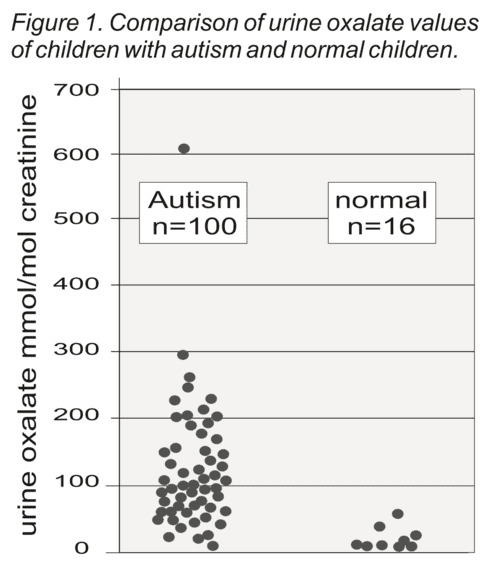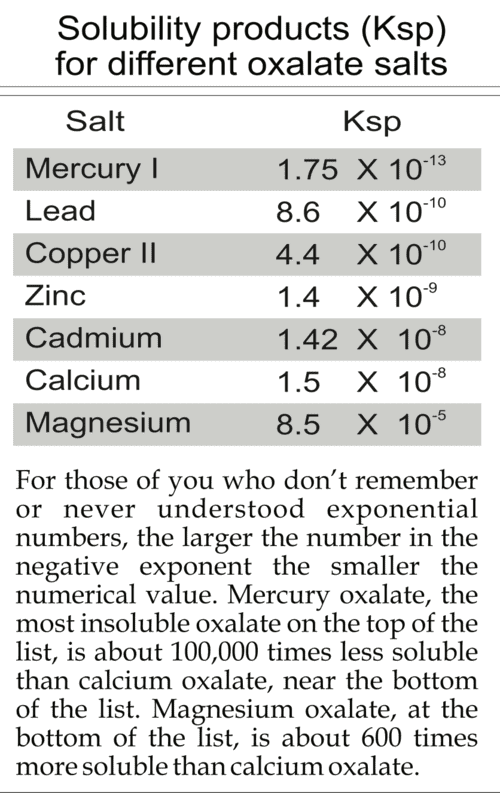TEST IMPLICATIONS FOR YEAST AND HEAVY METALS
WILLIAM SHAW, PH.D.
What are Oxalates?
Oxalate and its acid form oxalic acid are organic acids that are primarily from three sources: the diet, from fungus such as Aspergillus, Penicillium, and possibly Candida (1-9), and also from human metabolism (10).
Oxalic acid is the most acidic organic acid in body fluids and is used commercially to remove rust from car radiators. Antifreeze (ethylene glycol) is toxic primarily because it is converted to oxalate. Two different types of genetic diseases are known in which oxalates are high in the urine. The genetic types of hyperoxalurias (type I and type II) can be determined from the Organic Acids Test (OAT) done at The Great Plains Laboratory. Foods especially high in oxalates include spinach, beets, chocolate, peanuts, wheat bran, tea, cashews, pecans, almonds, berries, and many others. Oxalates are not found in meat or fish at significant concentrations. Daily adult oxalate intake is usually 80-120 mg/d; it can range from 44-1000 mg/d in individuals who eat a typical Western diet. A complete list of high oxalate foods is available at http://patienteducation.upmc.com/Pdf/LowOxalateDiet.pdf.
High oxalate in the urine and plasma was first found in people who were susceptible to kidney stones. Many kidney stones are composed of calcium oxalate. Stones can range in size from the diameter of a grain of rice to the width of a golf ball. It is estimated that 10% of males may have kidney stones some time in their life. Because many kidney stones contain calcium, some people with kidney stones think they should avoid calcium supplements. However, the opposite is true. When calcium is taken with foods that are high in oxalates, oxalic acid in the intestine combines with calcium to form insoluble calcium oxalate crystals that are eliminated in the stool. This form of oxalate cannot be absorbed into the body. When calcium is low in the diet, oxalic acid is soluble in the liquid portion of the contents of the intestine (called chyme) and is readily absorbed from the intestine into the bloodstream. If oxalic acid is very high in the blood being filtered by the kidney, it may combine with calcium to form crystals that may block urine flow and cause severe pain.
Such crystals may also form in the bones, joints, blood vessels, lungs, and even the brain (10-13). In addition, oxalate crystals in the bone may crowd out the bone marrow cells, leading to anemia and immunosuppression (13). In addition to autism and kidney disease, individuals with fibromyalgia and women with vulvar pain (vulvodynia) may suffer from the effects of excess oxalates (14,15).
Oxalate crystals may cause damage to various tissues. The sharp crystals may cause damage due to their physical structure and may also increase inflammation. Iron oxalate crystals may also cause significant oxidative damage and diminish iron stores needed for red blood cell formation (10). Oxalates may also function as chelating agents and may chelate many toxic metals such as mercury and lead. Unlike other chelating agents, oxalates trap heavy metals in the tissues.
Many parents who told me of adverse vaccine reactions of their children reported that their child was on antibiotics at the time of vaccination. Yeast overgrowth, commonly associated with antibiotic usage, might lead to increased oxalate production and increased combination with mercury, slowing mercury elimination if oxalates were so high that they deposited in the bones with attached mercury. It would be interesting to see if increased elimination of heavy metals occurs after oxalate elimination by antifungal therapy and low oxalate diet. In addition, oxalates from the diet or from yeast/fungus in the gastrointestinal tract bind calcium, magnesium, and zinc, perhaps leading to deficiencies even when dietary sources should be adequate.
Oxalates and Autism

Oxalates in the urine are much higher in individuals with autism than in normal children (Figure 1). As a matter of fact, 36% of the children on the autistic spectrum had values higher than 90 mmol/mol creatinine, the value consistent with a diagnosis of genetic hyperoxalurias while none of the normal children had values this high. 84% of the children on the autistic spectrum had oxalate values outside the normal range (mean ± 2 sd). None of the ± 2 sd). None of the children on the autistic spectrum had elevations of the other organic acids associated with genetic diseases of oxalate metabolism, indicating that oxalates are high due to external sources.
As shown in the table, both mean and median values for urine oxalates are substantially higher in autism compared to the normal population. As a matter of fact the mean oxalate value of 90.1 mmol/mol creatinine is equal to the lower cutoff value for the genetic hyperoxalurias. The median value in autism is six times the normal median value and the mean value in autism is five times the normal mean value.

A brand new diet is being extensively used to treat children with autism and other disorders. Researcher named Susan Owens discovered that the use of a diet low in oxalates markedly reduced symptoms in children with autism and PDD. For example, a mother with a son with autism reported that he became more focused and calm, that he played better, that he walked better, and had a reduction in leg and feet pain after being on a low oxalate diet. Prior to the low oxalate diet, her child could hardly walk up the stairs. After the diet, he walked up the stairs very easily. Many hundreds of children with autism throughout the world are now being placed on this diet with good results.
Benefits Reported By Parents Using Low Oxalate Diet
Improvements in gross and fine motor skills
Improvements in expressive speech
Better counting ability
Better receptive and expressive language
Increased imitation skills
Increased sociability
Speaking in longer sentences
Decreased rigidity
Better sleep
Reduced self-abusive behavior
Increased imaginary play
Improved cognition
Loss of bed wetting
Loss of frequent urination
Improved handwriting
Improved fine motor skills
Improvement in anemia
… and many others
How Can High Oxalates Be Treated?
Use antifungal drugs to reduce yeast and fungi that may be causing high oxalate. Children with autism frequently require years of antifungal treatment. I have noticed that arabinose, a marker used for years for yeast/fungal overgrowth on the Organic Acids Test (OAT) at The Great Plains Laboratory, is correlated with high amounts of oxalates (Table 2 and Figure 2) and arabinose has been found to be an important fuel for fungal oxalate production (5). Candida organisms have been found surrounding oxalate stones in the kidney (9).
Give supplements of calcium citrate to reduce oxalate absorption from the intestine. Citrate is the preferred calcium form to reduce oxalate because citrate also inhibits oxalate absorption from the intestinal tract. The best way to administer calcium citrate would be to give it with each meal. Children over the age of 2 need about 1000 mg of calcium per day. Of course, calcium supplementation may need to be increased if the child is on a milk-free diet. The most serious error in adopting the gluten-free, casein-free diet is the failure to adequately supplement with calcium.
Try N-Acetyl glucosamine to stimulate the production of the intercellular cement hyaluronic acid to reduce pain caused by oxalates (16).
Give chondroitin sulfate to prevent the formation of calcium oxalate crystals (17).
Vitamin B6 is a cofactor for one of the enzymes that degrade oxalate in the body and has been shown to reduce oxalate production (18).
Increase water intake to help to eliminate oxalates.
Excessive fats in the diet may cause elevated oxalate if the fatty acids are poorly absorbed because of bile salt deficiency. Non-absorbed free fatty acids bind calcium to form insoluble soaps, reducing calcium’s ability to bind oxalate and reduce oxalate absorption (19). If taurine is low in the Amino Acids Test, supplementation with taurine may help stimulate bile salt production (taurocholic acid), leading to better fatty acid absorption and diminished oxalate absorption.
Probiotics may be very helpful in degrading oxalates in the intestine. Individuals with low amounts of oxalate-degrading bacteria are much more susceptible to kidney stones (20). Both Lactobacillus acidophilus and Bifidobacterium lactis have enzymes that degrade oxalates (21).
Increase intake of essential omega-3 fatty acids, commonly found in fish oil and cod liver oil, which reduces oxalate problems (22). High amounts of the omega-6 fatty acid, arachidonic acid, are associated with increased oxalate problems (23). Meat from grain fed animals is high in arachidonic acid.
Take supplements of vitamin E, selenium, and arginine which have been shown to reduce oxalate damage (24, 25).
Undertake a low oxalate diet. This may be especially important if the individual has had Candida for long periods of time and there is high tissue oxalate buildup. There may be an initial bad reaction lasting several days to a week after starting the diet since oxalates deposited in the bones may begin to be eliminated as oxalates in the diet are reduced.
Evaluate vitamin C intake. Vitamin C can break down to form oxalates. However, in adults, the amount of oxalate formed did not increase until the amount exceeded 4 g of vitamin C per day (26). A large study of more than 85,000 women found no relation between vitamin C intake and kidney stones (27). In addition, an evaluation of 100 children on the autistic spectrum at The Great Plains Laboratory revealed that there was nearly zero correlation between vitamin C and oxalates in the urine (Table 2). Megadoses (more than 100 mg/Kg body weight per day) of vitamin C were shown to markedly reduce autistic symptoms in a double blind placebo controlled study (28) so any restriction of vitamin C needs to be carefully weighed against its significant benefits.
Oxalate Metabolism
In the genetic disease hyperoxaluria type I and in vitamin B-6 deficiency, there is a deficiency in the enzyme activity of alanine glyoxylate amino transferase (AGT), leading to the accumulation of glyoxylic acid. The high glyoxylic acid can then be converted to glycolate by the enzyme GRHPR or to oxalate by the enzyme LDH. Thus, glycolate, glyoxylate, and oxalate are the metabolites that are then elevated in the Organic Acids Test (OAT) in hyperoxaluria type I and in vitamin B-6 deficiency.
In the genetic disease hyperoxaluria type II, there is a deficiency in an enzyme (GRHPR) that has two biochemical activities: glyoxylate reductase and hydroxypyruvic reductase. This enzyme converts glyoxylate to glycolate and glycerate to hydroxypyruvate. When this enzyme is deficient, glycerate cannot be converted to hydroxypyruvate and glyoxylate cannot be converted to glycolate. In this disease, glyoxylate is increasingly converted to oxalate and glycerate is also very elevated.
External sources of oxalates include ethylene glycol, the main component of antifreeze. Antifreeze is toxic mainly because of the oxalates formed from it. In addition, some foods also contain small amounts of ethylene glycol. Vitamin C (ascorbic acid or ascorbate) can be converted to oxalates but apparently the biochemical conversion system is saturated at low levels of vitamin C so that no additional oxalate is formed until very large doses (greater than 4 g per day) are consumed. It is interesting that fungi can also produce vitamin C which may explain why many children with autism have high vitamin C even though they do not take supplements containing vitamin C. The high correlation between arabinose and oxalates indicate that intestinal yeast/fungal overgrowth is likely the main cause for elevated oxalates in the autistic spectrum population. The deposition of oxalates in critical tissues such as brain and blood vessels, the oxidative damage caused by oxalate salts, and the deposition of oxalate mercury complexes in the tissues may all be important factors in the core etiology of autism.
[Insert OAT Sample Test Result – Oxalate Section]
Oxalate Interconversions
Oxalic acid undergoes many conversions depending on the acidity of the environment in which it is present. The acidity of a water solution is usually indicated by a value called the pH. A very low pH like 0 or 1 indicates a very acidic solution while a pH of 13 or 14 would represent a very alkaline solution. A pH of 7 indicates a condition of neutrality. Blood has a pH of 7.4 which is very slightly alkaline. The pH of urine varies between 4.5 to 8 with an average of 6. Oxalic acid can lose a positively charged hydrogen ion or proton at a very low pH. The first pK value for oxalic acid (1.27) indicates the pH in which there are equal amounts of oxalic acid and its form missing a proton called monobasic oxalate. At a higher pH, the monobasic oxalate converts to a dibasic oxalate form with two negative charges. The second pK value for oxalate (4.28) indicates the pH at which there are equal values of monobasic and dibasic oxalates. At the pH of blood, which is extremely constant, virtually all oxalate is in the dibasic form. Because the pH of urine varies greatly, oxalate is mainly in the dibasic form in average urine while it is in both the monobasic and dibasic form in very acidic urine samples. When oxalates are tested, they are all converted to the same form before testing so they may be termed oxalates, oxalate, or oxalic acid.
Insolubility is a Key Factor in Oxalate Toxicity
Solubility of oxalate at body temperature is only approximately 5 mg/L at a pH of 7.0. The solubility of oxalic acid in water, in contrast, is approximately 106,000 mg/L. Thus, the oxalate form of oxalic acid is extremely insoluble. At most physiological pH values, oxalate salts are predominant. Oxalate has the ability to form salts with a wide variety of metals but each of these salts has a different solubility. A yardstick for measuring solubilities of different salts is called the solubility product constant or Ksp. The smaller the value of the Ksp, the greater the insolubility of a salt. Another way to express this is that the lower the Ksp, the greater the tendency of that salt to form insoluble crystals that may form in tissues. The table below lists the Ksp salts of oxalic acid in their order of solubility with the most insoluble salts listed at the top.
What is the importance of these solubility product numbers?

First, the Ksp for calcium oxalate indicates that whenever the product of the concentration of calcium and oxalate concentrations in blood exceeds the Ksp, calcium oxalate crystals may form and deposit in the tissues. Since the calcium concentration in blood hardly varies because of homeostatic mechanisms, it is the oxalate concentration in blood that varies widely and that determines whether or not calcium oxalate crystals form and deposit in the tissues. Zinc oxalate also has a very small Ksp so that if oxalates are present in high quantities in the intestinal tract, most of the zinc oxalate formed will not be absorbed because it is highly insoluble.
Second, mercury oxalate had the lowest Ksp of any oxalate salt that I could find. If an individual is exposed to inorganic mercury and has high oxalates in the blood or tissues, insoluble mercury oxalates may form in the blood and tissues that are unable to be eliminated.
The mercury used in vaccines as a preservative is an organic form that is converted to inorganic mercury. If an individual who is vaccinated is on antibiotics or was on antibiotics in the past, they may have extensive yeast/fungal overgrowth of the intestinal tract. They would absorb significant amounts of oxalates from these organisms that would trap mercury in the tissues and prevent its elimination. Many parents who talked with me indicated that their children had bad vaccine reactions while on antibiotics at the time of vaccination.
Third, magnesium oxalates are much more soluble than calcium oxalates. Thus, if magnesium supplements are given by themselves, oxalates from food or yeast/fungal sources that combine with magnesium are much more likely to be absorbed than calcium oxalates. However, transdermal magnesium or magnesium from Epsom salts baths that enters the blood and tissues through the skin might help to dissolve calcium or mercury oxalate crystals that had already formed in the blood or tissues.
Testing for Oxalates
The most convenient way of testing oxalates is with the Organic Acids Test (OAT) from The Great Plains Laboratory, Inc.
The Organic Acids Test checks for the presence of:
- Oxalic acid (oxalates) -Tests for all forms of oxalic acid and its salts or conjugate bases, oxalates
- Arabinose – Important Candida indicator which strongly correlates with oxalates
- Glycolic acid (glycolate)- Indicator of genetic disease of oxalate metabolism called Hyperoxaluria type I due to a deficiency in the enzyme activity of alanine glyoxylate amino transferase (AGT).
- Glyceric acid (glycerate) – Indicator of genetic disease of oxalate metabolism called Hyperoxaluria type II due to a deficiencyin an enzyme (GRHPR) that has two biochemical activities: glyoxylate reductase (GR) and hydroxypyruvic reductase (HPR).
- Ascorbic acid (ascorbate, vitamin C) – Indicates nutritional intake of vitamin C and/or excessive destruction. Vitamin C can be excessively converted to oxalates when free copper is very high. Evaluate further with copper/zinc profile from The Great Plains Laboratory.
- Pyridoxic acid – Indicator of vitamin B-6 intake. The enzyme activity alanine glyoxylate amino transferase (AGT) requires vitamin B-6 to eliminate glyoxylic acid or glyoxylate, a major source of excess oxalates.
- Furandicarboxylic acid, hydroxy-methylfuroic acid – Markers for fungi such as Aspergillus infection, one of the proven sources of oxalates
- Bacteria markers – A high amount of bacterial markers may indicate low values of beneficial bacteria such as Lactobacilli species that have the ability to destroy oxalates.
High Oxalate Food List
The foods below contain more than 10 mg oxalate per serving. A more detailed list is available online from the University of Pittsburgh Schools of the Health Sciences website.
Drinks
– Dark or “robust” beer
– Black tea
– Chocolate milk
– Cocoa
– Instant coffee
– Hot chocolate
– Juice made from high oxalate fruits (see below for high oxalate fruits)
– Ovaltine
– Soy drinks
Dairy
– Chocolate milk
– Soy cheese
– Soy milk
– Soy yogurt
Fats, Nuts, Seeds
– Nuts
– Nut butters
– Sesame seeds
– Tahini
– Soy nuts
Starch
– Amaranth
– Buckwheat
– Cereal (bran or high fiber
– Crisp bread (rye or wheat)
– Fruit cake
– Grits
– Pretzels
– Taro
– Wheat bran
– Wheat germ
– Whole wheat bread
– Whole wheat flour
Condiments
– Black pepper (more than 1 tsp.)
– Marmalade
– Soy sauce
Miscellaneous
– Chocolate
– Parsley
Fruit
– Blackberries
– Blueberries
– Carambola
– Concord grapes
– Currents
– Dewberries
– Elderberries
– Figs
– Fruit cocktail
– Gooseberry
– Kiwis
– Lemon peel
– Orange peel
– Raspberries
– Rhubarb
– Canned strawberries
– Tamarillo
– Tangerines
Vegetables
– Beans (baked, green, dried, kidney)
– Beets
– Beet greens
– Beet root
– Carrots
Vegetables Continued…
– Celery
– Chicory
– Collards
– Dandelion greens
– Eggplant
– Escarole
– Kale
– Leeks
– Okra
– Olives
– Parsley
– Peppers (chili and green)
– Pokeweed
– Potatoes (baked, boiled, fried)
– Rutabaga
– Spinach
– Summer squash
– Sweet potato
– Swiss chard
– Zucchini
REFERENCES
1. Tsao, G. Appl Microbiol. 1963 May; 11(3): 249-254. Production of Oxalic Acid by a Wood-Rotting Fungus.
2. Takeuchi H Konishi T, Tomoyoshi T. Observation on fungi within urinary stones. Hinyokika Kiyo. 1987 May;33(5):658-61.
3. Lee SH, Barnes WG, Schaetzel WP. Pulmonary aspergillosis and the importance of oxalate crystal recognition in cytology specimens. Arch Pathol Lab Med. 1986 Dec;110(12):1176-9.
4. Muntz FH. Oxalate-producing pulmonary aspergillosis in an alpaca. Vet Pathol. 1999 Nov;36(6):631-2.
5. Loewus FA, Saito K, Suto RK, Maring E. Conversion of D-arabinose to D-erythroascorbic acid and oxalic acid in Sclerotinia sclerotiorum. Biochem Biophys Res Commun. 1995 Jul 6;212(1):196-203.
6. Fomina M, Hillier S, Charnock JM, Melville K, Alexander IJ, Gadd GM. Role of oxalic acid overexcretion in transformations of toxic metal minerals by Beauveria caledonica. Appl Environ Microbiol. 2005 Jan;71(1):371-81.
7. Ruijter, G.J.G., van de Vondervoort, P.J.I. & Visser, J. (1999) Oxalic acid production by Aspergillus niger: an oxalate-non-producing mutant produces citric acid at pH 5 and in the presence of manganese. Microbiology 145, 2569–2576.
8. Ghio AJ, Peterseim DS, Roggli VL, Piantadosi CA. Pulmonary oxalate deposition associated with Aspergillus niger infection. An oxidant hypothesis of toxicity. Am Rev Respir Dis. 1992 Jun;145(6):1499-502.
9. Takeuchi H, Konishi T, Tomoyoshi T. Detection by light microscopy of Candida in thin sections of bladder stone. Urology. 1989 Dec;34(6):385-7.
10. Ghio AJ, Roggli VL, Kennedy TP, Piantadosi CA. Calcium oxalate and iron accumulation in sarcoidosis. Sarcoidosis Vasc Diffuse Lung Dis. 2000 Jun;17(2):140-50.
11. Ott SM, Andress DL, Sherrard DJ. Bone oxalate in a long-term hemodialysis patient who ingested high doses of vitamin C. Am J Kidney Dis. 1986 Dec;8(6):450-4.
12. Hall BM, Walsh JC, Horvath JS, Lytton DG. Peripheral neuropathy complicating primary hyperoxaluria. J Neurol Sci. 1976 Oct;29(2-4):343-9.
13. Sahin G, Acikalin MF, Yalcin AU. Erythropoietin resistance as a result of oxalosis in bone marrow. Clin Nephrol. 2005 May;63(5):402-4.
14. Sarma AV, Foxman B, Bayirli B, Haefner H, Sobel JD. Epidemiology of vulvar vestibulitis syndrome: an exploratory case-control study. Sex Transm Infect. 1999 Oct;75(5):320-6.
15. http://www.thevpfoundation.org/effective_treatment.htm
16. Shirane Y, Kurokawa Y, Miyashita S, Komatsu H, Kagawa S. Study of inhibition mechanisms of glycosaminoglycans on calcium oxalate monohydrate crystals by atomic force microscopy. Urol Res. 1999 Dec;27(6):426-31.
17. Chetyrkin SV, Kim D, Belmont JM, Scheinman JI, Hudson BG, Voziyan PA. Pyridoxamine lowers kidney crystals in experimental hyperoxaluria: a potential therapy for primary hyperoxaluria.
18. Sangaletti O, Petrillo M, Bianchi Porro G. Urinary oxalate recovery after oral oxalic load: an alternative method to the quantitative determination of stool fat for the diagnosis of lipid malabsorption. J Int Med Res. 1989 Nov-Dec;17(6):526-31.
19. Kumar R, Mukherjee M, Bhandari M, Kumar A, Sidhu H, Mittal RD. Role of Oxalobacter formigenes in calcium oxalate stone disease: a study from North India. Eur Urol. 2002 Mar;41(3):318-22.
20. Azcarate-Peril MA, Bruno-Barcena JM, Hassan HM, Klaenhammer TR. Transcriptional and functional analysis of oxalyl-coenzyme A (CoA) decarboxylase and formyl-CoA transferase genes from Lactobacillus acidophilus. Appl Environ Microbiol. 2006 Mar;72(3):1891-9.
21. Baggio B, Gambaro G, Zambon S, Marchini F, Bassi A, Bordin L, Clari G, Manzato E. Anomalous phospholipid n-6 polyunsaturated fatty acid composition in idiopathic calcium nephrolithiasis. J Am Soc Nephrol. 1996 Apr;7(4):613-20.
22. Gambaro G, Bordoni A, Hrelia S, Bordin L, Biagi P, Semplicini A, Clari G, Manzato E, Baggio B. Dietary manipulation of delta-6-desaturase modifies phospholipid arachidonic acid levels and the urinary excretion of calcium and oxalate in the rat: insight in calcium lithogenesis. J Lab Clin Med. 2000 Jan;135(1):89-95.
23. Santhosh Kumar M, Selvam R. Supplementation of vitamin E and selenium prevents hyperoxaluria in experimental urolithic rats. J Nutr Biochem. 2003 Jun;14(6):306-13.
24. Pragasam V, Kalaiselvi P, Sumitra K, Srinivasan S, Varalakshmi P. Pragasam V, Kalaiselvi P, Sumitra K, Srinivasan S, Varalakshmi P. Counteraction of oxalate induced nitrosative stress by supplementation of l-arginine, a potent antilithic agent. Clin Chim Acta. 2005 Apr;354(1-2):159-66. Epub 2005 Jan 19.
25. Takenouchi KAso K, Kawase K, Ichikawa H, Shiomi T. On the metabolites of ascorbic acid, especially oxalic acid, eliminated in urine, following administration of large amounts of ascorbic acid. J Vitaminol (Kyoto). 1966 Mar 10;12(1):49-58.
26. Curhan, G. C., Willett, W. C., Speizer, F. E., Stampfer, M. J. Intake of vitamins B6 and C and the risk of kidney stones in women. J Am Soc Nephrol 10:4:840-845, Apr 1999
27. Dolske MC, Spollen J, McKay S, Lancashire E, Tolbert L. A preliminary trial of ascorbic acid as supplemental therapy for autism. Prog. Neuropsycho-pharmacol Biol Psychiatry. 1993 Sep;17(5):765-74.




